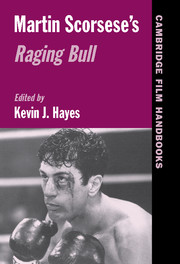Book contents
- Frontmatter
- Contents
- List of Illustrations
- List of Contributors
- Abbreviations
- Introduction: The Heritage and Legacy of Raging Bull
- 1 Art and Genre in Raging Bull
- 2 Visual Absurdity in Raging Bull
- 3 Raging Bull and the Idea of Performance
- 4 Women in Raging Bull: Scorsese's Use of Determinist, Objective, and Subjective Techniques
- 5 My Victims, My Melancholia: Raging Bull and Vincente Minnelli's The Bad and the Beautiful
- REVIEWS OF RAGING BULL
- Filmography
- Select Bibliography
- Index
3 - Raging Bull and the Idea of Performance
Published online by Cambridge University Press: 24 November 2009
- Frontmatter
- Contents
- List of Illustrations
- List of Contributors
- Abbreviations
- Introduction: The Heritage and Legacy of Raging Bull
- 1 Art and Genre in Raging Bull
- 2 Visual Absurdity in Raging Bull
- 3 Raging Bull and the Idea of Performance
- 4 Women in Raging Bull: Scorsese's Use of Determinist, Objective, and Subjective Techniques
- 5 My Victims, My Melancholia: Raging Bull and Vincente Minnelli's The Bad and the Beautiful
- REVIEWS OF RAGING BULL
- Filmography
- Select Bibliography
- Index
Summary
Performance studies can offer film studies much. Seen from the perspective of this emerging field of studies, Raging Bull becomes an even more complex work. Answers to such questions as who is performing and what is being performed are far from simple. As the opening sequence suggests, Raging Bull makes the idea of performance a predominant theme. The film examines how masculinity is performed within the boxing arena and without. In so doing, it begs comparison with the great stage plays of the mid-twentieth century that also interrogate the performance of masculinity. As a biographical film of a performer, Raging Bull shows Robert De Niro performing as Jake La Motta performing as both a boxer and as a stand-up comedian. Incorporating Brando's famous speech from On the Waterfront (1954) near its end, Raging Bull adds further layers of performance: De Niro as Jake as Brando as Terry Malloy. Through allusion and homage, this closing scene has been re-performed numerous times since the film's release, and additional layers of complexity accumulate as Raging Bull gathers history.
BEGINNING BETWEEN DOING AND SEEMING
Raging Bull begins with a very specific circumstance of performance. In the opening title sequence, a boxer spars with the smokey air in an empty ring. Only vague movements are visible from those just outside the ropes; flashbulbs occasionally burst through the gloom.
- Type
- Chapter
- Information
- Martin Scorsese's Raging Bull , pp. 69 - 91Publisher: Cambridge University PressPrint publication year: 2005

